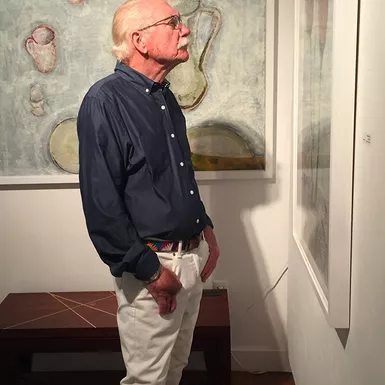
Jim Hamilton was born in 1931 in Buffalo, NewYork. He attended George School for two years. After graduating from high school, he studied drawing for a semester at the Art Institute of Buffalo. He enlisted in the U.S. Army in 1950. He was discharged in 1952 after being wounded in the Korean conflict.
Jim Hamilton attended the Pennsylvania Academy of the Fine Arts from 1952 to 1955 and again from 1959 to 1960. In 1955 he was awarded the Louis S. Ware Memorial Scholarship for European Travel by the Academy and one of his paintings was purchased for the Academy’s collection.
After finishing art school he worked in the advertising and commercial art fields.
In 1974 he obtained a Bachelor of Fine Arts degree from the Philadelphia University of Art, and in 1978 he received a law degree from Temple University while working as the art director and direct mail marketing manager for TV Guide’ subscription department.
In 1978 Jim and his wife, Laura Rizio, started the law firm of Rizio and Hamilton, PC, specializing in personal injury law. Jim practiced law for 37 years. Jim’s work has progressed from post impressionism to pure abstraction and is in many private collections as well as national museums.
After finishing art school at the Pennsylvania Academy I worked mostly in woodcuts. The prints were in a loose realistic/expressionist style. Until 2005, I painted in a post-impressionist manner. But the style became repetitive and unfulfilling. In 2005 I shifted direction.
I started painting in a semi-figurative style. This work combined synthetic cubist and abstract expressionist forms exploring themes found in contemporary and ancient culture in art, literature, film, political speech, popular media, internet, etc. The paintings evolved from gestural notations towards universal themes, such as violence, sex, lust for power, transcendence, desire for immortality; the pervasive themes of human endeavor. They contained diverse references: pop films (Kill Bill, Troy), 18th century Japanese woodcuts, Mycenaean artifacts, Homer’s Iliad, Sumerian clay tablets, architecture, landscape, figures, etc.
In 2015, I added a series of landscapes inspired by the work of Richard Diebenkorn. Most of these were large canvases (48 x 40) and contained very little referential material. About two years later I transitioned to hard edge color field paintings influenced by the works of such artists as Lyonel Feininger, Josef Albers, Richard Diebenkorn, and Mark Rothko, etc.
Jim Hamilton, 2022